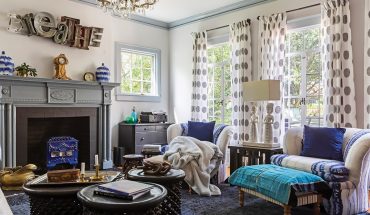by Liza Roberts
photographs by Geoff Wood
When Dan Forest, newly sworn-in as lieutenant governor of North Carolina, walked into the stately Victorian house with the wrap-around porch on Blount Street that was to be his office, he was amazed.
The Hawkins-Hartness House, built in 1882, was in a state. Rooms hadn’t been painted in 30 years. Electrical wires snaked around in tangled knots. Furniture was frayed; hardwood and linoleum floors were in disrepair; dangling fluorescent lights strobed disconcertingly. “Is this really where you want to bring constituents?” he asked himself. “This is the people’s house.”
Still, “it’s got good bones,” he recalls thinking. “You could do something with it.” The house, built by Raleigh residents Dr. and Mrs. Alexander Hawkins, was sold in 1928 to Secretary of State James Hartness and his wife. In 1969, it was acquired by the state and used as the State Department of Local Affairs and the Department of Historical Preservation before becoming the office of the lieutenant governor in 1988.
An architect by trade and the former senior partner of North Carolina’s largest architectural firm, Little Diversified Architectural Consulting of Durham, Forest knows something about good bones.
But he quickly learned that bones or no bones, “doing something with it” would be no simple task. There wasn’t any state money to fund a renovation, much less a simple paint job.
So he did what any self-respecting politician does instinctively: He asked for donations. Not donations to himself or to his party, but to the state-owned house: flooring, painting, countertops, appliances, window shades, cabinetry, lighting, antiques restoration, new furniture, even project management. He asked North Carolina businesses he knew from his architecture days, companies like furniture and office interiors company CBI, Cary Reconstruction Co., Charlotte Flooring, Kitchen and Bath Galleries, Mannington Commercial Carpet, Absolute Stone, and Budget Blinds. They all said yes.
“The project took on a life of its own,” he says. “Once people saw what we were doing, they got engaged. They offered things and did things I would have been embarrassed to even ask for.” State facilities workers chipped in, too, repairing faulty wiring and plumbing.
Forest also rolled up his own sleeves and got his wife and four children to roll up theirs, too. On weekends they left their North Raleigh house to come downtown and paint, clean, and polish woodwork, sew curtains, hang light fixtures, and turn bathtubs into small settees with handmade upholstered cushions. “We put a lot of sweat equity into it. We got creative.”
Five months later, the work was done, unveiled with a May 20 reception for 300, the first of many events Forest has since held in the restored house. He wants to show it off: “It’s the best office in state government now.”
 With its central four-story tower, elaborate roofline, and deep covered porch, the 8,200-square-foot Victorian – a close cousin to the governor’s mansion a few doors down – now offers a compelling combination of restored grandeur with a modern aesthetic. Contemporary chandeliers illuminate the house’s original dining room table, now restored and in service as a conference table. Upstairs, the jolt of contemporary furniture is in keeping, Forest says, with the spirit of the house’s own Eastlake Victorian style. “It’s a more modern version of Victorian,” he says, “so it makes sense to take a modernist approach upstairs,” where carved wainscoting and sleek Knoll chairs make crisp neighbors.
With its central four-story tower, elaborate roofline, and deep covered porch, the 8,200-square-foot Victorian – a close cousin to the governor’s mansion a few doors down – now offers a compelling combination of restored grandeur with a modern aesthetic. Contemporary chandeliers illuminate the house’s original dining room table, now restored and in service as a conference table. Upstairs, the jolt of contemporary furniture is in keeping, Forest says, with the spirit of the house’s own Eastlake Victorian style. “It’s a more modern version of Victorian,” he says, “so it makes sense to take a modernist approach upstairs,” where carved wainscoting and sleek Knoll chairs make crisp neighbors.
The furniture and the rest are a boon for the house and the state, Forest says. “I’m just amazed that people would step up to do this. Good-hearted people who want their state to look good, and put their best foot forward for no return.”
Forest now has his eye on several of the other large, state-owned, elaborate Victorians in various states of repair that line Blount Street. All spruced up, wouldn’t they together make a terrific consulate row, he wonders? Countries around the world are eager to take part in our state’s growing economy, he says: Perhaps they’d undertake a Victorian house renovation as part of the bargain? An architect-turned-lieutenant-governor can dream.

The intern room features sleek furniture, fresh paint, and restored floors. The bright-green radiator outside the room was painted by the lieutenant governor. Carved railing posts, detailed wainscoting, high ceilings, and wide refinished floorboards make a refined backdrop for modernist furniture in the upstairs hall, bottom left. A carved bannister post features the simpler decoration common to the late Queen Anne Victorian style known as Eastlake. Forest and his family cleaned and polished the house’s woodwork, bottom right.





